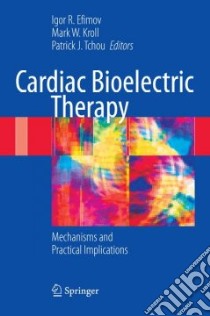Cardiac Bioelectric Therapy - 9780387794020
Un libro in lingua di Efimov Igor R. (EDT) Kroll Mark W. (EDT) Tchou Patrick J. (EDT) edito da Springer Verlag, 2009
- € 235.40
- Il prezzo è variabile in funzione del cambio della valuta d’origine
Pacing and defibrillation have become the leading therapeutic treatments of heart rhythm disorders, including bradycardia and tachycardia. The success of these therapies is largely due to centuries of scientific inquiry into the fundamental mechanisms of bioelectric phenomena in the heart. History of successful development of bioelectric therapies includes development of experimental and theoretical methodologies, novel bioengineering approaches, and state-of-the-art clinical implantable device therapies. The purpose of this book is to present a uniform thematic collection of reviews written by the leading basic and applied scientists working in basic bioengineering research laboratories, who have contributed to the development of current understanding of the fundamental mechanisms of pacing and electrophysiology, and who are at the leading edge of further developments in electrotherapy. The book will start from the historic overview of the subject, including the development of the pacemaker and defibrillator, evolution of theories of cardiac arrhythmias and experimental methods used in the field over the centuries. Leading experts in the field will write these chapters. The second part of the book will focus on rigorous treatment of the fundamental theory of interaction between electric field and cardiac cell, tissue, and organ. Chapters will be written by top notch scientists, who made critically important contributions to the development of these theories. Part 3 will provide summary of several decades of research involving electrode recordings and multielectrode mapping of ventricular fibrillation and defibrillation in humans and animal models of arrhythmias. Part 4 will present new insights into defibrillation gained due to the advent of optical imaging technology, which permitted to map defibrillation without overwhelming shock-induced artifacts present in electrode recordings. Part 5 will provide rigorous overview of the methodologies, which made research of physiological and engineering aspects of electrotherapy possible. And finally, part 6 will present possible future of implantable devices and electrotherapy in the treatment of cardiac rhythm disorders.
Informazioni bibliografiche
- Titolo del Libro in lingua: Cardiac Bioelectric Therapy
- Sottotitolo: Mechanisms and Practical Implications
- Lingua: English
- Autori : Efimov Igor R. (EDT) Kroll Mark W. (EDT) Tchou Patrick J. (EDT)
- Editore: Springer Verlag
- Collana: Springer Verlag (Hardcover)
- Data di Pubblicazione: 28 Febbraio '09
- Genere: MEDICAL
- Argomenti : Cardiovascular instruments, Implanted Electrotherapeutics Electrophysiology
- Pagine: 634
- Dimensioni mm: 254 x 177 x 31
- ISBN-10: 0387794026
- EAN-13: 9780387794020


